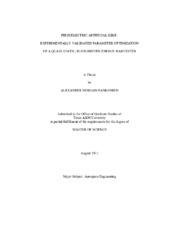| dc.contributor.advisor | Ounaies, Zoubeida | |
| dc.creator | Pankonien, Alexander Morgan | |
| dc.date.accessioned | 2011-10-21T22:03:58Z | |
| dc.date.accessioned | 2011-10-22T07:12:17Z | |
| dc.date.available | 2011-10-21T22:03:58Z | |
| dc.date.available | 2011-10-22T07:12:17Z | |
| dc.date.created | 2011-08 | |
| dc.date.issued | 2011-10-21 | |
| dc.date.submitted | August 2011 | |
| dc.identifier.uri | https://hdl.handle.net/1969.1/ETD-TAMU-2011-08-10099 | |
| dc.description.abstract | Piezoelectric energy harvesting is the process of taking an external mechanical input and converting it directly into electrical energy via the piezoelectric effect. To determine the power created by a piezoelectric energy harvester, a specific application with defined input and design constraints must first be chosen. The following thesis established a concept design of a hydrokinetic energy harvesting system, the piezoelectric artificial kelp (PAK), which uses piezoelectric materials to harvest coastal ocean waves while having a beneficial impact on the surrounding environment. The harvester design mimics the configuration of sea-kelp, a naturally occurring plant that anchors to the ocean floor and extends into the water column. Underwater currents caused by wave-action result in periodic oscillations in the kelp. In order to determine the average power generated by this design concept, predictive tools were devised that allowed for the determination of the optimized average power produced by the piezoelectric energy harvester. For a stiff energy harvester, the linear differential equations were analytically solved to find an equation for the average power generated as a function of design parameters. These equations were used to compare the effect on power output of the design configuration and piezoelectric material choice between a piezopolymer (PVDF) and a piezoceramic (PZT). The homogeneous bimorph was found to have the optimal design configuration and it was shown that a harvester constructed using PVDF would produce approximately 1.6 times as much power as one using PZT. For a flexible energy harvester, an iterative nonlinear solution technique using an assumed polynomial solution for the local curvature of the energy harvester was used to verify and extend the analytic solutions to large deflections. An energy harvester was built using off-the-shelf piezoelectric elements and tested in a wave tank facility to validate experimentally the voltage and average power predicted by the analytical solution. The iterative code showed the PAK harvester to produce volumetric power on the order of other energy harvesting concepts (17.8 micro [mu]W/cm³). Also, a full-scale PAK harvester approximately ten meters long in typical wave conditions was found to produce approximately one watt of power. | en |
| dc.format.mimetype | application/pdf | |
| dc.language.iso | en_US | |
| dc.subject | Piezoelectric | en |
| dc.subject | Low Frequency | en |
| dc.subject | Energy Harvesting | en |
| dc.subject | Alternative Energy | en |
| dc.title | Piezoelectric Artificial Kelp: Experimentally Validated Parameter Optimization of a Quasi-Static, Flow-Driven Energy Harvester | en |
| dc.type | Thesis | en |
| thesis.degree.department | Aerospace Engineering | en |
| thesis.degree.discipline | Aerospace Engineering | en |
| thesis.degree.grantor | Texas A&M University | en |
| thesis.degree.name | Master of Science | en |
| thesis.degree.level | Masters | en |
| dc.contributor.committeeMember | Randall, Robert | |
| dc.contributor.committeeMember | Hurtado, John | |
| dc.type.genre | thesis | en |
| dc.type.material | text | en |


